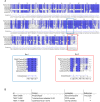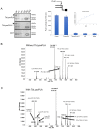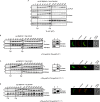A novel lipase with dual localisation in Trypanosoma brucei
- PMID: 35306507
- PMCID: PMC8934347
- DOI: 10.1038/s41598-022-08546-w
A novel lipase with dual localisation in Trypanosoma brucei
Abstract
Phospholipases are esterases involved in lipid catabolism. In pathogenic micro-organisms (bacteria, fungi, parasites) they often play a critical role in virulence and pathogenicity. A few phospholipases (PL) have been characterised so far at the gene and protein level in unicellular parasites including African trypanosomes (AT). They could play a role in different processes such as host-pathogen interaction, antigenic variation, intermediary metabolism. By mining the genome database of AT we found putative new phospholipase candidate genes and here we provided biochemical evidence that one of these has lipolytic activity. This protein has a unique non-canonical glycosome targeting signal responsible for its dual localisation in the cytosol and the peroxisomes-related organelles named glycosomes. We also show that this new phospholipase is excreted by these pathogens and that antibodies directed against this protein are generated during an experimental infection with T. brucei gambiense, a subspecies responsible for infection in humans. This feature makes this protein a possible tool for diagnosis.
© 2022. The Author(s).
Conflict of interest statement
The authors declare no competing interests.
Figures





References
-
- Van den Bossche P. Some general aspects of the distribution and epidemiology of bovine trypanosomosis in southern Africa. Int. J. Parasitol. 2001;31:592–598. - PubMed
-
- Dennis EA. 9 Phospholipases. In: Boyer PD, editor. The Enzymes. Elsevier; 1983. pp. 307–353.
-
- Aoki J, Inoue A, Makide K, Saiki N, Arai H. Structure and function of extracellular phospholipase A1 belonging to the pancreatic lipase gene family. Biochimie. 2007;89:197–204. - PubMed
Publication types
MeSH terms
Substances
LinkOut - more resources
Full Text Sources

